Unit 3 Careers and skills Welcome to the unit 课件(共26张PPT)-2025-2026学年译林版(2019)选择性必修第四册
文档属性
| 名称 | Unit 3 Careers and skills Welcome to the unit 课件(共26张PPT)-2025-2026学年译林版(2019)选择性必修第四册 | 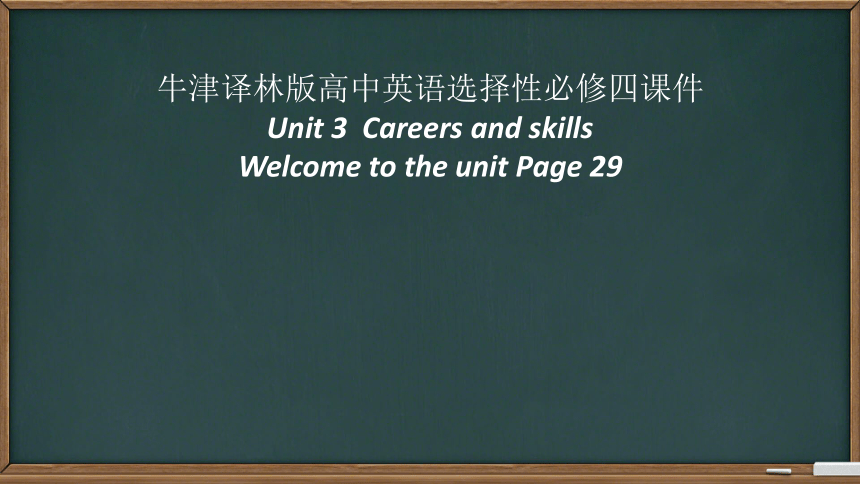 | |
| 格式 | pptx | ||
| 文件大小 | 268.9KB | ||
| 资源类型 | 教案 | ||
| 版本资源 | 牛津译林版(2019) | ||
| 科目 | 英语 | ||
| 更新时间 | 2025-07-17 11:33:20 | ||
图片预览

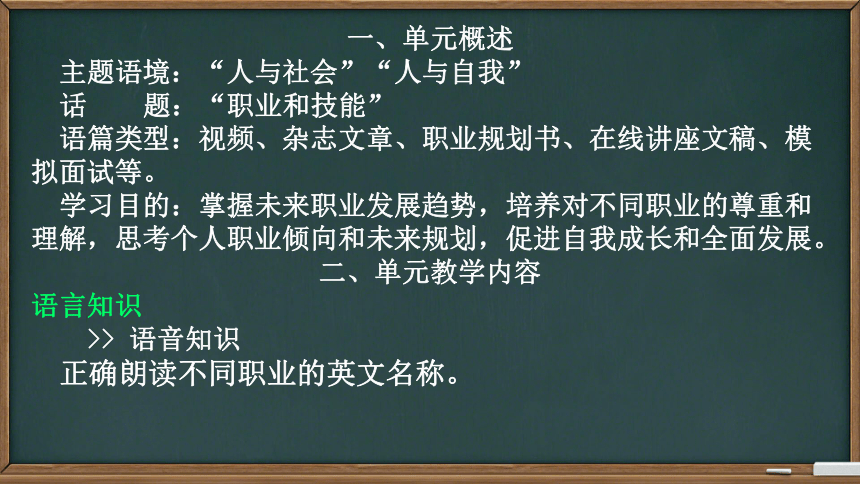
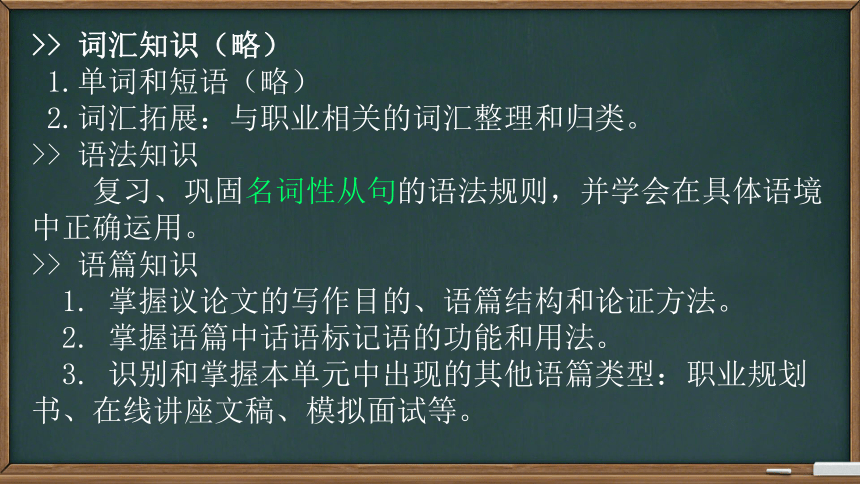
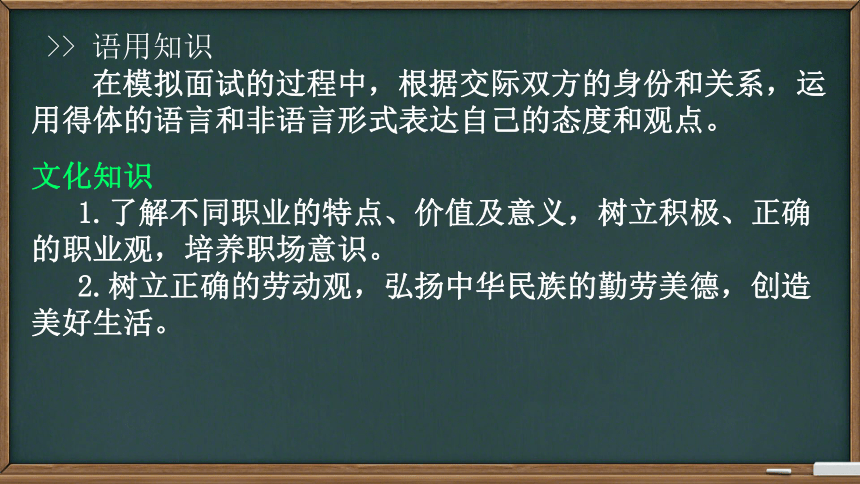
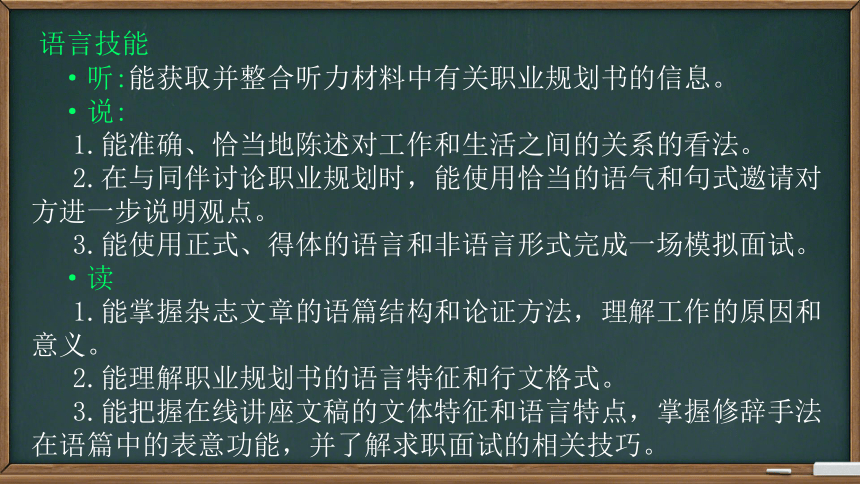
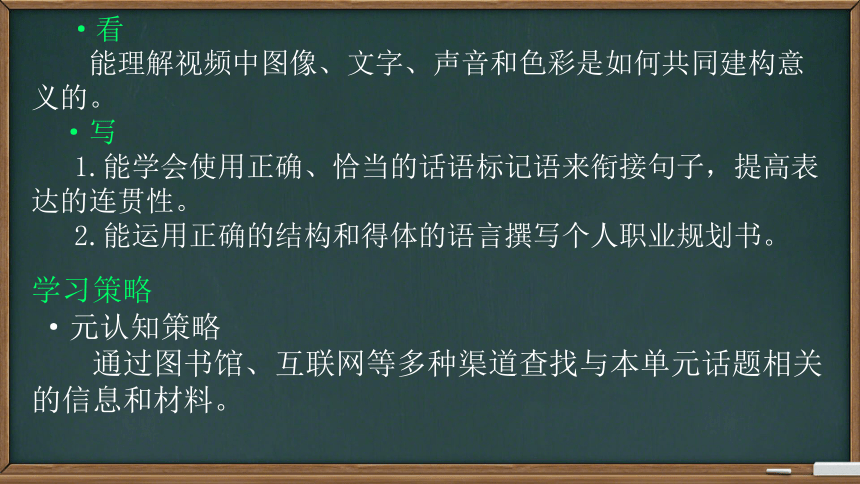
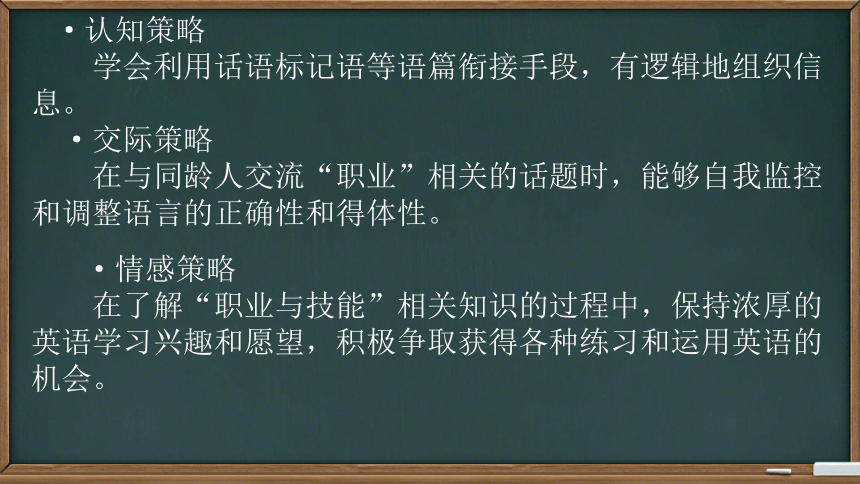
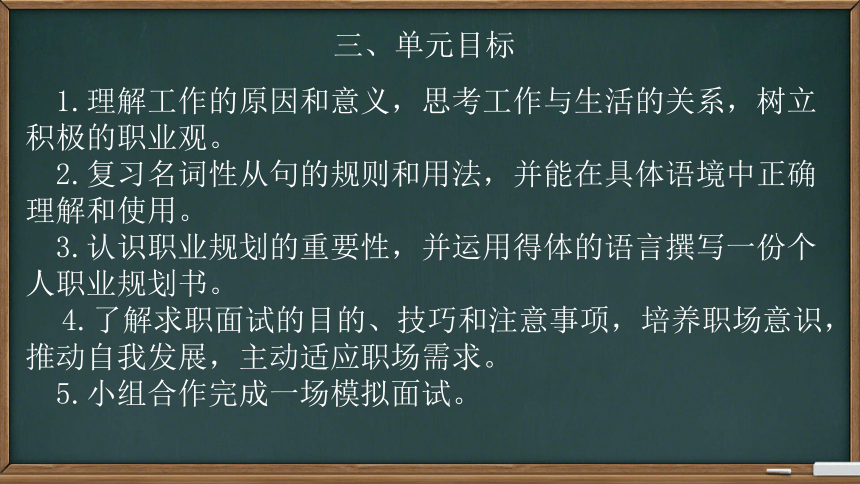
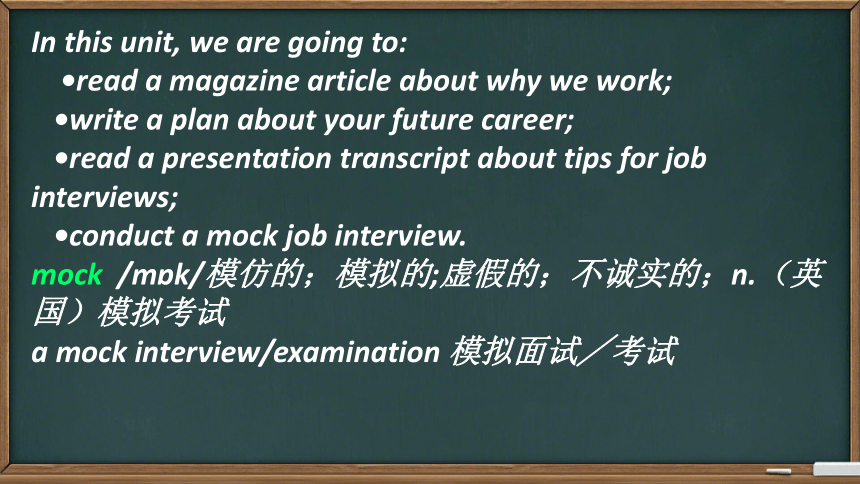
文档简介
(共26张PPT)
牛津译林版高中英语选择性必修四课件
Unit 3 Careers and skills
Welcome to the unit Page 29
一、单元概述
主题语境:“人与社会”“人与自我”
话 题:“职业和技能”
语篇类型:视频、杂志文章、职业规划书、在线讲座文稿、模拟面试等。
学习目的:掌握未来职业发展趋势,培养对不同职业的尊重和理解,思考个人职业倾向和未来规划,促进自我成长和全面发展。
二、单元教学内容
语言知识
>> 语音知识
正确朗读不同职业的英文名称。
>> 词汇知识(略)
1.单词和短语(略)
2.词汇拓展:与职业相关的词汇整理和归类。
>> 语法知识
复习、巩固名词性从句的语法规则,并学会在具体语境中正确运用。
>> 语篇知识
1. 掌握议论文的写作目的、语篇结构和论证方法。
2. 掌握语篇中话语标记语的功能和用法。
3. 识别和掌握本单元中出现的其他语篇类型:职业规划书、在线讲座文稿、模拟面试等。
>> 语用知识
在模拟面试的过程中,根据交际双方的身份和关系,运用得体的语言和非语言形式表达自己的态度和观点。
文化知识
1.了解不同职业的特点、价值及意义,树立积极、正确的职业观,培养职场意识。
2.树立正确的劳动观,弘扬中华民族的勤劳美德,创造美好生活。
语言技能
·听:能获取并整合听力材料中有关职业规划书的信息。
·说:
1.能准确、恰当地陈述对工作和生活之间的关系的看法。
2.在与同伴讨论职业规划时,能使用恰当的语气和句式邀请对方进一步说明观点。
3.能使用正式、得体的语言和非语言形式完成一场模拟面试。
·读
1.能掌握杂志文章的语篇结构和论证方法,理解工作的原因和意义。
2.能理解职业规划书的语言特征和行文格式。
3.能把握在线讲座文稿的文体特征和语言特点,掌握修辞手法在语篇中的表意功能,并了解求职面试的相关技巧。
·看
能理解视频中图像、文字、声音和色彩是如何共同建构意义的。
·写
1.能学会使用正确、恰当的话语标记语来衔接句子,提高表达的连贯性。
2.能运用正确的结构和得体的语言撰写个人职业规划书。
学习策略
·元认知策略
通过图书馆、互联网等多种渠道查找与本单元话题相关的信息和材料。
·认知策略
学会利用话语标记语等语篇衔接手段,有逻辑地组织信息。
·交际策略
在与同龄人交流“职业”相关的话题时,能够自我监控和调整语言的正确性和得体性。
·情感策略
在了解“职业与技能”相关知识的过程中,保持浓厚的英语学习兴趣和愿望,积极争取获得各种练习和运用英语的机会。
三、单元目标
1.理解工作的原因和意义,思考工作与生活的关系,树立积极的职业观。
2.复习名词性从句的规则和用法,并能在具体语境中正确理解和使用。
3.认识职业规划的重要性,并运用得体的语言撰写一份个人职业规划书。
4.了解求职面试的目的、技巧和注意事项,培养职场意识,推动自我发展,主动适应职场需求。
5.小组合作完成一场模拟面试。
In this unit, we are going to:
read a magazine article about why we work;
write a plan about your future career;
read a presentation transcript about tips for job
interviews;
conduct a mock job interview.
mock /m k/模仿的;模拟的;虚假的;不诚实的;n.(英国)模拟考试
a mock interview/examination 模拟面试╱考试
Welcome to the unit
◆ 内容分析
本板块的话题为“工匠精神”,教学活动通过多模态语篇——视频,介绍了书画修复师这一传统而特殊的职业。视频帮助我们了解书画修复工作的特点,启发我们就“工匠精神”的内涵展开讨论,进而激发我们进一步探究“职业和技能”这一话题的兴趣,树立正确的职业观,为单元学习作好准备。
◆ 教学目标
By the end of this section, we will be able to:
1. interpret the quote highlighting the significance of all occupations;
2. gain knowledge of Chinese calligraphy and painting restoration;
3. share their understanding of the spirit of craftsmanship;
4. give examples of other professions which demonstrate the spirit of craftsmanship.工匠精神
res·tor·ation / rest re n/ 整修;修复
crafts·man·ship / krɑ ftsm n p/手艺;技艺;精工细作
All occupations are equal, with no difference in status or worth. Any one that is beneficial to the public is praiseworthy.
—Huang Yanpei
“职业平等,无高下,无贵贱。苟有益于人群,皆是无上上品。”
oc·cu·pa·tion / kju pe n/ [ C]a job or profession工作;职业
praise·worthy / pre zw i/ adj.值得称赞的;值得表扬的
Every profession has its own distinctive character. Watch the video and finish the following exercises.
The process of restoring artworks is ___________.
Restoring an artwork sometimes takes _______________
__________. Some may even take years.
________ is an important quality for restorers.
Artworks that need to be restored represent our
_________________.
dis·tinct·ive /d st kt v/ adj.独特的;特别的;有特色的
restorer/r st r /修建者; 修补者; 修复者
complicated
several months or a year
Patience
history and culture
Video script
Host: Papermaking is one of China’s ancient inventions. Calligraphy and paintings on paper have existed in China for thousands of years, and over many years, the
artworks get damaged. This is when a restorer comes in. Today, we are honoured to have Mr Wang with us, a well-known calligraphy and painting restorer. Mr Wang, as a restorer, what is your routine work like Is it mysterious as many people imagine
come in在…中起作用;参与
Restorer: As a matter of fact, there’s nothing mysterious about our work. We’re like doctors, and the ancient artworks are our patients that need to be treated.
Host: Restoring those artworks must be very complicated.
Restorer: That’s true. Most of the artworks have different problems. Some have lots of mould on them, some have been damaged by worms, and some are very easy to
break. We need to be very careful.
mould /m ld/ 霉;霉菌;(独特)类型,个性,风格;模具;铸模
worm /w m/ 寄生虫;肠虫;(昆虫的)幼虫
Host: How do you get rid of the mould
Restorer: We wash some away with clean water. But the stubborn mould needs special treatment to get rid of, for example, using chemicals. After cleaning the artworks, we go through a complicated process to give them new life.
Host:How long will it take for one artwork to be restored
wash sb/sth away冲掉;冲走
stub·born / st b n/ adj.难以去除(或对付)的;固执的;执拗的;顽固的;倔强的
Restorer: It depends. Sometimes several months, or a year. Some may even take years.
Host: So, your work calls for not just carefulness, but also patience.
Restorer: Exactly! Patience is an important quality for us restorers. You need to concentrate all your attention on your work, day in day out, and focus on one thing only.
Host: What is required of a restorer
That depends./It (all) depends.那得看情况
call for sth需要;(公开)要求
day in day out日复一日,天天(指不间断)
Restorer: Actually, a restorer must have professional knowledge, and be skilled in the art of painting and restoring.
Host:The spirit of craftsmanship is the key to doing anything well. Your hands have restored artworks that represent our history and culture. We really appreciate your work!
Restorer: Thank you! And it’s important to pass on the spirit of craftsmanship to the next generation, so I encourage more young people to join us.
skilled in/at (doing) sth/sk ld/ 有技能的;熟练的
pass sth on (to sb)转交;(用后)递给,传给
1.What is your understanding of the spirit of craftsmanship
To me, the spirit of craftsmanship refers to the dedication craftspeople give to their work in order to strive to be the best and to make their crafts as perfect as possible. They have a passion for their crafts, while paying attention to the small details that make them special and unique.
ded·ica·tion / ded ke n/ 献身;奉献
strive (for/against sth) /stra v/ 努力;奋斗;力争;力求
Craftspeople are known for their inventive talent and superb skills. In addition to those traits, craftspeople are also characterized by their professional ethics, pursuit of quality and ability to innovate.
craftspeople/ krɑ ftspi p l/手艺人; 工匠
in·vent·ive / n vent v/ adj.(尤指人 ) 善于创新的;有创意的;(思想 ) 有新意的;有创意的
trait /tre t/ (人的个性的)特征,特性,特点
char·ac·ter·ize / k r kt ra z/ 是…的特征;以…为典型;使…具有特点(或最引人注目的特征)
professional ethics职业道德
2.What other professions demonstrate the spirit of craftsmanship How is it shown
The spirit of craftsmanship requires craftspeople to use their hands to create works of high quality. This spirit is demonstrated in professions like painters, sculptors, carpenters, paper cutting artists, tailors, and even cheese-makers and wine-makers. All these professions require craftspeople who are passionate, patient and knowledgeable.
sculp·tor / sk lpt (r)/ 雕刻家;雕塑家
carpenter / kɑ p nt (r)/ 木工;木匠
pas·sion·ate / p n t/ 热诚的;狂热的
3. What are the most important professions in your opinion
In my opinion, all kinds of professions are equally important to the well-being of society and the country. However, I think there are certain jobs which contribute a lot more to our society, such as soldiers, policemen, firemen, etc.
well-being 健康;安乐;康乐
4. How do you understand the quote from Huang Yanpei
I think the quote means that all jobs should be treated with respect because they are all important and necessary, but those that benefit society require extra recognition. I think the attitude indicated in this quote should be cultivated in our society.
rec·og·ni·tion/ rek ɡ n n/ 承认;认可;赞誉;赏识;奖赏
in·di·cate / nd ke t/ 表明;显示;象征;暗示;暗示;间接提及;示意
cul·ti·vate / k lt ve t/ 逐渐形成(某种态度、谈话或举止方式等)
5. Why should we restore damaged ancient Chinese calligraphy and paintings
Chinese calligraphy and paintings are symbols of Chinese culture and history.The restoration work ensures that these cultural relics can be passed down to future generations.
6.How can we attract more young people to join the restoration work
We can invite them to visit museums or work as volunteers there. It can help them understand the importance of restoring ancient artworks as well as
protecting our culture and history.
7.How can you apply the spirit of craftsmanship to your studies
The spirit of craftsmanship involves not only great skills, but also determination.Inspired by it, I will concentrate all my attention on my studies and strive to achieve a higher level of results.
牛津译林版高中英语选择性必修四课件
Unit 3 Careers and skills
Welcome to the unit Page 29
一、单元概述
主题语境:“人与社会”“人与自我”
话 题:“职业和技能”
语篇类型:视频、杂志文章、职业规划书、在线讲座文稿、模拟面试等。
学习目的:掌握未来职业发展趋势,培养对不同职业的尊重和理解,思考个人职业倾向和未来规划,促进自我成长和全面发展。
二、单元教学内容
语言知识
>> 语音知识
正确朗读不同职业的英文名称。
>> 词汇知识(略)
1.单词和短语(略)
2.词汇拓展:与职业相关的词汇整理和归类。
>> 语法知识
复习、巩固名词性从句的语法规则,并学会在具体语境中正确运用。
>> 语篇知识
1. 掌握议论文的写作目的、语篇结构和论证方法。
2. 掌握语篇中话语标记语的功能和用法。
3. 识别和掌握本单元中出现的其他语篇类型:职业规划书、在线讲座文稿、模拟面试等。
>> 语用知识
在模拟面试的过程中,根据交际双方的身份和关系,运用得体的语言和非语言形式表达自己的态度和观点。
文化知识
1.了解不同职业的特点、价值及意义,树立积极、正确的职业观,培养职场意识。
2.树立正确的劳动观,弘扬中华民族的勤劳美德,创造美好生活。
语言技能
·听:能获取并整合听力材料中有关职业规划书的信息。
·说:
1.能准确、恰当地陈述对工作和生活之间的关系的看法。
2.在与同伴讨论职业规划时,能使用恰当的语气和句式邀请对方进一步说明观点。
3.能使用正式、得体的语言和非语言形式完成一场模拟面试。
·读
1.能掌握杂志文章的语篇结构和论证方法,理解工作的原因和意义。
2.能理解职业规划书的语言特征和行文格式。
3.能把握在线讲座文稿的文体特征和语言特点,掌握修辞手法在语篇中的表意功能,并了解求职面试的相关技巧。
·看
能理解视频中图像、文字、声音和色彩是如何共同建构意义的。
·写
1.能学会使用正确、恰当的话语标记语来衔接句子,提高表达的连贯性。
2.能运用正确的结构和得体的语言撰写个人职业规划书。
学习策略
·元认知策略
通过图书馆、互联网等多种渠道查找与本单元话题相关的信息和材料。
·认知策略
学会利用话语标记语等语篇衔接手段,有逻辑地组织信息。
·交际策略
在与同龄人交流“职业”相关的话题时,能够自我监控和调整语言的正确性和得体性。
·情感策略
在了解“职业与技能”相关知识的过程中,保持浓厚的英语学习兴趣和愿望,积极争取获得各种练习和运用英语的机会。
三、单元目标
1.理解工作的原因和意义,思考工作与生活的关系,树立积极的职业观。
2.复习名词性从句的规则和用法,并能在具体语境中正确理解和使用。
3.认识职业规划的重要性,并运用得体的语言撰写一份个人职业规划书。
4.了解求职面试的目的、技巧和注意事项,培养职场意识,推动自我发展,主动适应职场需求。
5.小组合作完成一场模拟面试。
In this unit, we are going to:
read a magazine article about why we work;
write a plan about your future career;
read a presentation transcript about tips for job
interviews;
conduct a mock job interview.
mock /m k/模仿的;模拟的;虚假的;不诚实的;n.(英国)模拟考试
a mock interview/examination 模拟面试╱考试
Welcome to the unit
◆ 内容分析
本板块的话题为“工匠精神”,教学活动通过多模态语篇——视频,介绍了书画修复师这一传统而特殊的职业。视频帮助我们了解书画修复工作的特点,启发我们就“工匠精神”的内涵展开讨论,进而激发我们进一步探究“职业和技能”这一话题的兴趣,树立正确的职业观,为单元学习作好准备。
◆ 教学目标
By the end of this section, we will be able to:
1. interpret the quote highlighting the significance of all occupations;
2. gain knowledge of Chinese calligraphy and painting restoration;
3. share their understanding of the spirit of craftsmanship;
4. give examples of other professions which demonstrate the spirit of craftsmanship.工匠精神
res·tor·ation / rest re n/ 整修;修复
crafts·man·ship / krɑ ftsm n p/手艺;技艺;精工细作
All occupations are equal, with no difference in status or worth. Any one that is beneficial to the public is praiseworthy.
—Huang Yanpei
“职业平等,无高下,无贵贱。苟有益于人群,皆是无上上品。”
oc·cu·pa·tion / kju pe n/ [ C]a job or profession工作;职业
praise·worthy / pre zw i/ adj.值得称赞的;值得表扬的
Every profession has its own distinctive character. Watch the video and finish the following exercises.
The process of restoring artworks is ___________.
Restoring an artwork sometimes takes _______________
__________. Some may even take years.
________ is an important quality for restorers.
Artworks that need to be restored represent our
_________________.
dis·tinct·ive /d st kt v/ adj.独特的;特别的;有特色的
restorer/r st r /修建者; 修补者; 修复者
complicated
several months or a year
Patience
history and culture
Video script
Host: Papermaking is one of China’s ancient inventions. Calligraphy and paintings on paper have existed in China for thousands of years, and over many years, the
artworks get damaged. This is when a restorer comes in. Today, we are honoured to have Mr Wang with us, a well-known calligraphy and painting restorer. Mr Wang, as a restorer, what is your routine work like Is it mysterious as many people imagine
come in在…中起作用;参与
Restorer: As a matter of fact, there’s nothing mysterious about our work. We’re like doctors, and the ancient artworks are our patients that need to be treated.
Host: Restoring those artworks must be very complicated.
Restorer: That’s true. Most of the artworks have different problems. Some have lots of mould on them, some have been damaged by worms, and some are very easy to
break. We need to be very careful.
mould /m ld/ 霉;霉菌;(独特)类型,个性,风格;模具;铸模
worm /w m/ 寄生虫;肠虫;(昆虫的)幼虫
Host: How do you get rid of the mould
Restorer: We wash some away with clean water. But the stubborn mould needs special treatment to get rid of, for example, using chemicals. After cleaning the artworks, we go through a complicated process to give them new life.
Host:How long will it take for one artwork to be restored
wash sb/sth away冲掉;冲走
stub·born / st b n/ adj.难以去除(或对付)的;固执的;执拗的;顽固的;倔强的
Restorer: It depends. Sometimes several months, or a year. Some may even take years.
Host: So, your work calls for not just carefulness, but also patience.
Restorer: Exactly! Patience is an important quality for us restorers. You need to concentrate all your attention on your work, day in day out, and focus on one thing only.
Host: What is required of a restorer
That depends./It (all) depends.那得看情况
call for sth需要;(公开)要求
day in day out日复一日,天天(指不间断)
Restorer: Actually, a restorer must have professional knowledge, and be skilled in the art of painting and restoring.
Host:The spirit of craftsmanship is the key to doing anything well. Your hands have restored artworks that represent our history and culture. We really appreciate your work!
Restorer: Thank you! And it’s important to pass on the spirit of craftsmanship to the next generation, so I encourage more young people to join us.
skilled in/at (doing) sth/sk ld/ 有技能的;熟练的
pass sth on (to sb)转交;(用后)递给,传给
1.What is your understanding of the spirit of craftsmanship
To me, the spirit of craftsmanship refers to the dedication craftspeople give to their work in order to strive to be the best and to make their crafts as perfect as possible. They have a passion for their crafts, while paying attention to the small details that make them special and unique.
ded·ica·tion / ded ke n/ 献身;奉献
strive (for/against sth) /stra v/ 努力;奋斗;力争;力求
Craftspeople are known for their inventive talent and superb skills. In addition to those traits, craftspeople are also characterized by their professional ethics, pursuit of quality and ability to innovate.
craftspeople/ krɑ ftspi p l/手艺人; 工匠
in·vent·ive / n vent v/ adj.(尤指人 ) 善于创新的;有创意的;(思想 ) 有新意的;有创意的
trait /tre t/ (人的个性的)特征,特性,特点
char·ac·ter·ize / k r kt ra z/ 是…的特征;以…为典型;使…具有特点(或最引人注目的特征)
professional ethics职业道德
2.What other professions demonstrate the spirit of craftsmanship How is it shown
The spirit of craftsmanship requires craftspeople to use their hands to create works of high quality. This spirit is demonstrated in professions like painters, sculptors, carpenters, paper cutting artists, tailors, and even cheese-makers and wine-makers. All these professions require craftspeople who are passionate, patient and knowledgeable.
sculp·tor / sk lpt (r)/ 雕刻家;雕塑家
carpenter / kɑ p nt (r)/ 木工;木匠
pas·sion·ate / p n t/ 热诚的;狂热的
3. What are the most important professions in your opinion
In my opinion, all kinds of professions are equally important to the well-being of society and the country. However, I think there are certain jobs which contribute a lot more to our society, such as soldiers, policemen, firemen, etc.
well-being 健康;安乐;康乐
4. How do you understand the quote from Huang Yanpei
I think the quote means that all jobs should be treated with respect because they are all important and necessary, but those that benefit society require extra recognition. I think the attitude indicated in this quote should be cultivated in our society.
rec·og·ni·tion/ rek ɡ n n/ 承认;认可;赞誉;赏识;奖赏
in·di·cate / nd ke t/ 表明;显示;象征;暗示;暗示;间接提及;示意
cul·ti·vate / k lt ve t/ 逐渐形成(某种态度、谈话或举止方式等)
5. Why should we restore damaged ancient Chinese calligraphy and paintings
Chinese calligraphy and paintings are symbols of Chinese culture and history.The restoration work ensures that these cultural relics can be passed down to future generations.
6.How can we attract more young people to join the restoration work
We can invite them to visit museums or work as volunteers there. It can help them understand the importance of restoring ancient artworks as well as
protecting our culture and history.
7.How can you apply the spirit of craftsmanship to your studies
The spirit of craftsmanship involves not only great skills, but also determination.Inspired by it, I will concentrate all my attention on my studies and strive to achieve a higher level of results.
同课章节目录
